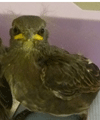November
By studying animal behaviour we gain an insight into our own

It is time to learn from our similarities with animal behaviour rather than just the differences, argues Newcastle University's Dr Tom Smulders.
 The senior lecturer in the Centre for Behaviour and Evolution writes in The Conversation:
The senior lecturer in the Centre for Behaviour and Evolution writes in The Conversation:
In the field of animal behaviour, there is one topic that is almost guaranteed to get your study in the popular press: showing how an animal behaves just like humans. This can be solving problems, using tools, acting pessimistically when feeling down, or taking care of their grandchildren. People love stories of seemingly clever animals.
Yet people usually only consider this comparison from one side: they are amazed that any other animals can be as intelligent, emotional or altruistic as humans can be. They never really consider what this comparison means for how we understand ourselves.
For centuries, philosophers and scientists have tried to understand what makes us unique. But people often forget that humans are not alone in being unique. Every species on the planet has some features that it shares with other species, and some that make it stand out. What the evolutionary approach allows us to do is to investigate which features or traits are shared with others and what that sharing tells us about the species in question.
Species can share a trait for two reasons: either the species are closely related and they have inherited the trait from their common ancestor, or the shared trait is an adaptation to similar evolutionary pressures. Both of these ways of looking at similarities can be enlightening when trying to understand the nature of humans.
Take a look at similarities derived from common ancestry. Everybody expects chimpanzees (and bonobos) to be similar to us, because they are our closest relatives. So when we look at them, we usually focus on the ways in which we differ from them. After all, any traits we don’t share with them must have evolved in our own lineage, and therefore be uniquely human.
There are two problems with this. First, any differences between us and chimps are just as likely to be due to changes in chimps since our last common ancestor as they are changes in us. So we can only start concluding that a trait has evolved through the human lineage if chimps share their traits with other apes and maybe even other primates, but we don’t.
Second, just because humans are the only primate that has a certain trait does not mean that trait is uniquely human. One obvious example is vocal learning. As far as we know, humans are the only primates who learn to make the sounds that comprise their means of communicating with one another. We call this trait “vocal learning”, and it is the basis for human speech and language. However, there are many other groups throughout the animal kingdom that learn their vocalisations, for example parrots and songbirds, seals and dolphins. So we’re far from unique in this case.
Situations like this allow us to use the natural experiment of evolution to understand the conditions under which vocal learning can evolve and apply this to human evolution as well.
In songbirds for example, song learning might have evolved through sexual selection – from females preferring mates with complex songs. Those males who could mimic sounds composed more complex songs, which gave their genes a better chance of being passed to the next generation. Analogously, some have suggested that human vocal learning may have originally evolved as a male sexual display, in other words singing. This is just one possibility, but it illustrates how comparative approaches can tell us more about ourselves.
Another example is that many animals, from pigs to bees, will act “pessimistically”, that is, respond as if they expect the worst following a bad experience. This is a common characteristic of humans in low mood as well. It’s still not clear what these animals experience subjectively, but the findings do give us a much deeper insight into why we respond to negative experiences the way we do. Increased caution after a bad experience may well be an evolutionary adaptation that increases our chances of survival.
So comparative approaches help us test hypotheses about ourselves that otherwise would remain pure speculation. It has long been thought that human females live long after the menopause, when they stop being fertile, in order to raise their children and grandchildren to adulthood. So this explanation would predict finding similar behaviour in other long-lived animals with similarly long-developing young as humans. And that is exactly what was found in killer whales (although it was not easy data to obtain), a corroboration that makes the explanation more likely in the case of humans too.
So next time you read a story about clever animals that are just like us, try to think about what this says about us and our, not their, evolutionary history. For a greater appreciation of the complexities of nature, try looking at both sides of the coin.
(Article re-published courtesy of The Conversation)

published on: 8 November 2013
